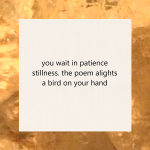haiku poems about spring
 the first rain of spring / smells like your lover’s body / asleep in your bed
the first rain of spring / smells like your lover’s body / asleep in your bed
 heavy grey, pure white / a drama of changing sky / blinding silver, blue
heavy grey, pure white / a drama of changing sky / blinding silver, blue
 once in my childhood / all the dandelions bloomed / while i was sleeping
once in my childhood / all the dandelions bloomed / while i was sleeping
 the sun pours herself / into the sea and the world / overflows with light
the sun pours herself / into the sea and the world / overflows with light
haiku poems about summer
 boom of a deep drum / rain dappling a silver lake / the sky grows brighter
boom of a deep drum / rain dappling a silver lake / the sky grows brighter
 clash of katydids / barefoot on the dew lush grass / the bright watching stars
clash of katydids / barefoot on the dew lush grass / the bright watching stars
 that shimmering sea / that blue day when our hearts burned / brighter than the sun
that shimmering sea / that blue day when our hearts burned / brighter than the sun
 the orange trumpets / bloom like fire, blow summer / a final fanfare
the orange trumpets / bloom like fire, blow summer / a final fanfare
haiku poems about fall
 in the light fresh breeze / a single leaf pirouettes / the air enchanted
in the light fresh breeze / a single leaf pirouettes / the air enchanted
 the drab dusk fading / a dirty orange smear like / the day gone to rust
the drab dusk fading / a dirty orange smear like / the day gone to rust
 on the bare brown branch / a fat squirrel anxiously eats / another acorn
on the bare brown branch / a fat squirrel anxiously eats / another acorn
 blooming in beauty / beauty when faded and dry / life and death are good
blooming in beauty / beauty when faded and dry / life and death are good
haiku poems about winter
 an old lost song and / the fog damp neck when your words / were warm on my neck
an old lost song and / the fog damp neck when your words / were warm on my neck
 when cold days turn dark / leaf the earth, lemon the sun / steam in summer’s cup
when cold days turn dark / leaf the earth, lemon the sun / steam in summer’s cup
 a pen and ink world / beautiful desolation / snow on ohio
a pen and ink world / beautiful desolation / snow on ohio
 through the cold branches / in a far corner of sky / a single star shines
through the cold branches / in a far corner of sky / a single star shines
Haiku about nature and the season are the customary topics for these poems. If you follow the traditional rules, images of nature and the seasons paired with an implicit emotion are the only acceptable elements of haiku.
For various reasons, I don’t follow these rules. Sometimes I present an image from nature and leave out the emotion although you’ll feel a mood. These haiku I think of as closer to landscape painting than poetry. Other times, I’ll make the emotion explicit, make a statement, or use metaphor or other poetic elements that traditional haiku avoid.
What I’m trying to find is a poem that hasn’t been written before. In a real sense, haiku as a poetic form has been perfected and the subject of nature in haiku has been exhausted. I’m not sure you can write a better haiku about winter than the ones already written, for example. I’m also not sure you can write a haiku about winter different from the ones already written.
One point of my work is to try to find a way to write about nature in haiku that is different from other poems already written, however. For the same reason, I’ll write haiku about love and haiku about death and other subjects outside of nature, or try to tell a story in 17 syllables, or look for emotions outside the set standard to poetry.
I don’t want to exclude nature from my work, because the experience of nature is a fundamental element of human experience. Even when you live in a city, the sky and light and weather are always present and nature is present too despite our best efforts to eradicate it. Sometimes nature is there poetically. The raptors that nest in skyscrapers and hunt the canyons between them. Sometimes nature is there unpoetically. The rat gnawing on a pizza slice between the subway tracks. For more thoughts, see my post on how to write haiku.


Leave a comment